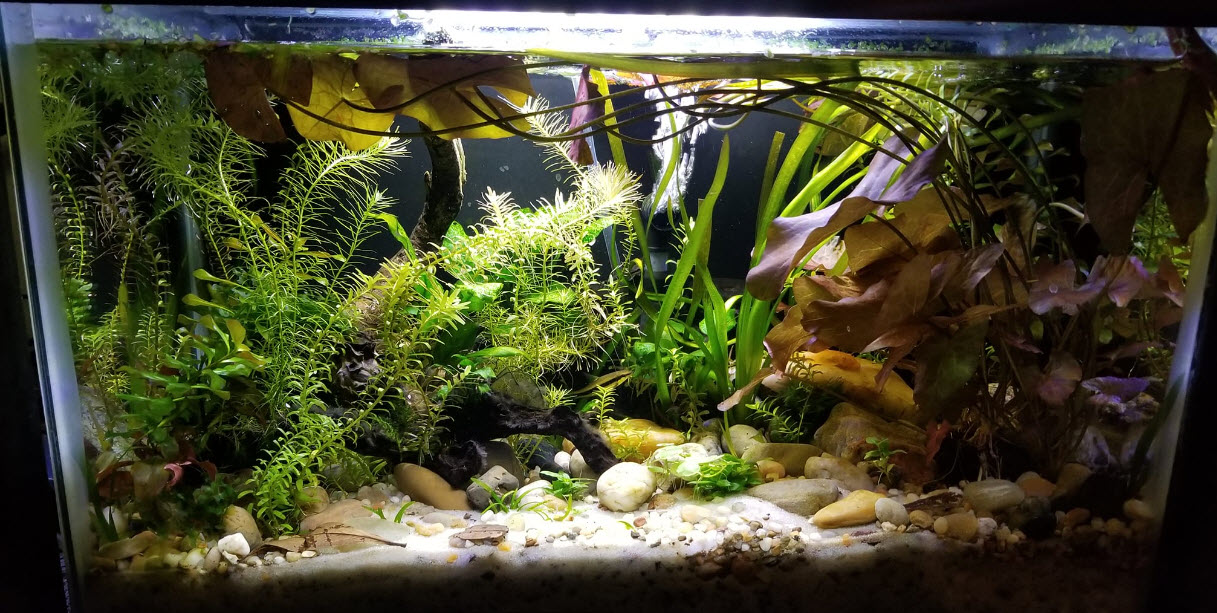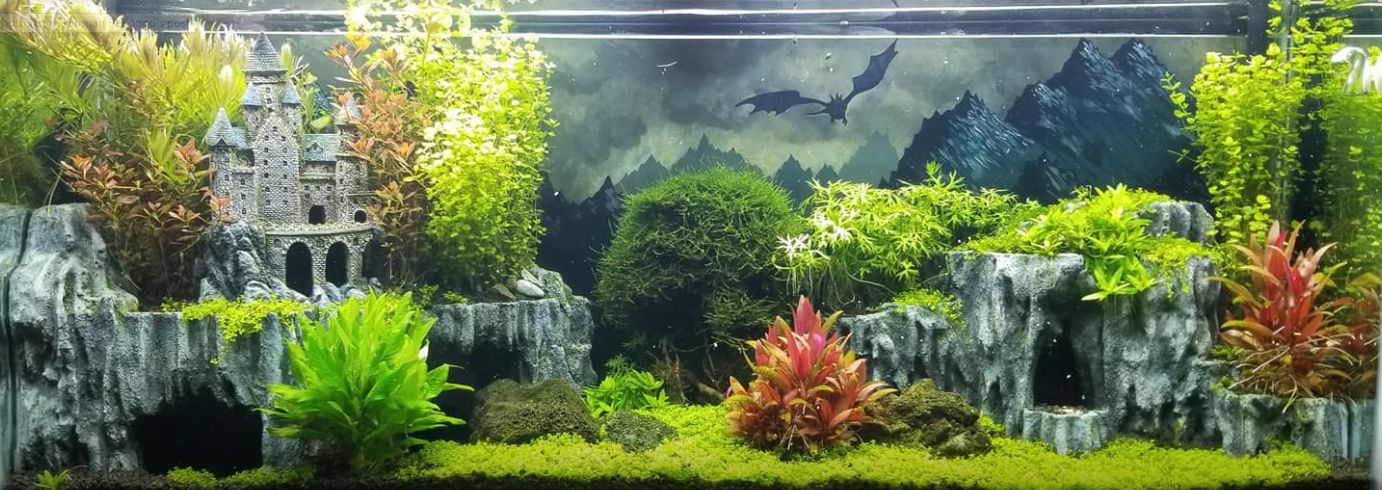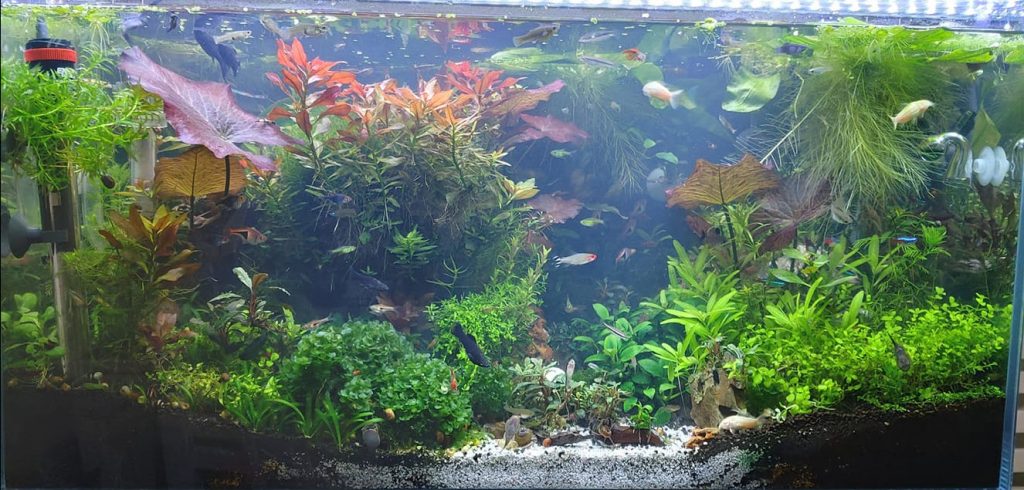
Adding a “natural” fertilizer like extra fish food is not a good idea if there is little biofiltration together with fish in the aquarium. The “natural” fertilizer produces dissolved organic compounds which feed heterotrophic bacteria. These bacteria cloud the water and compromise the fish’s immune system in the aquarium. But this type of fertilization can work well with a LOT of carefully crafted biofiltration.
Some folks add extra food to the water to provide fertilizer for the plants. Diana Walstad did this with her tanks (“Ecology of the Planted Aquarium”, the bible for planted tank enthusiasts). Initially, she didn’t use any biofiltration. Using food as a fertilizer in a tank without a modicum of biofiltration is asking for trouble. Ms. Walstad ended up with huge mortalities in her rainbowfish from fish TB.
Ms. Walstad then added some biofiltration to her tanks and the problem went away. So Ms. Walstad now recommends some biofiltration, with the caveat that the outflow needs to be low in the tank and baffled so as not to create any surface disturbance.

If one adds excess food as a “fertilizer” for plants. the excess food is decomposed rapidly by fast-growing bacteria called “heterotrophic” bacteria, i.e. bacteria which eat proteins and carbohydrates for food. If there is little or no biofiltration this results in a high bacteria count in the water. The fish that are present then need to devote significant portions of their immune system to ward off attacks by these heterotrophic bacteria. And they are then far more susceptible to attack by pathogens like fish TB or columnaris bacteria.
This method CAN be made to work if one very carefully adds a lot of biofiltration to the aquarium WITHOUT adding a lot of aeration. The added biofiltration removes the dissolved organic compounds. Ms. Walstad did that and her disease problems went away. But one has to put the water back into the tank low in the aquarium and avoid high flow at the surface of the aquarium.

Natural Chemical Fertilizers
And some folks say it is best to use “natural” organic fertilizers like potassium gluconate instead of “chemical” fertilizers like potassium sulfate. But there is a snag to that line of thought. In aquarium water, potassium gluconate becomes potassium ions and gluconate ions. The potassium ions have no association with the gluconate ions after dissolution.
The potassium is just positive ions along with the sodium, calcium, and magnesium ions. The same potassium ions could come from any potassium compound like potassium sulfate.
The gluconate ions which are then floating free are carbohydrates that feed bacteria and decrease the health of the fish, just like all “natural’ fertilizers. So again, the “natural” potassium gluconate is not a good idea.

Good Fertilizer Additions
If one is using fish food as the fertilizer there are two nutrients fish food does not supply very well. Vascular plants need easily three times more potassium than most fish food supplies. And fish food has often oxidized the iron to insoluble, unavailable forms.
So supplementation with a potassium fertilizer like potassium sulfate or bicarbonate and an iron fertilizer like ferrous sulfate is often very beneficial to plant growth. 10 ppm potassium (I.e. just a “pinch” of potassium salt the size of a barley grain per ten gallons) and 0.5 ppm ferrous iron (just a tiny pinch of ferrous sulfate as small as you can get per ten gallons) once or twice a week is very useful in tanks that use fish food as fertilizer .
Fertilizers in More Depth
We go into aquarium fertilizers in more depth in the following links:
15.5. Aquarium Fertilizing
15.5.1. Ready-Made Fertilizer
15.5.2. Fertilizer Programs
15.5.3. Estimative Index
15.5.4. NH4 + Tabs Fertilizer
15.5.5. DIY Epiphytic Fertilizer
15.5.7. DIY Fertilization
.
Return to Planted Aquarium Menu
.
Aquarium Science Website
The chapters shown below or on the right side in maroon lead to close to 400 articles on all aspects of keeping a freshwater aquarium. These articles have NO links to profit-making sites and are thus unbiased in their recommendations, unlike all the for-profit sites you will find with Google. Bookmark and browse!
.

Mik says
Oh and I’m going to mix up just straight K fertz recipe for FFAF tanks and see how that does on half my tanks. I’ll have to check and see if my saltwater aquarium phosphate test kit can reliably test in freshwater.
Mik says
Thanks as always for the feedback!
Most of the plants I have in our 9 freshwater tanks are epiphytes, but I do also have Amazon swords and a variety of stem plants. In addition to fish food, PK and iron fertz 3x a week (1mL/10gal) on alternating days, I also run a fatherfishesque setup. I’m going to post a comment over on the fatherfosh page you have about that in more detail, but the outcome is that I don’t have algae problems on the glass or anywhere else in the tank, I’m pretty please. I rarely do water changes. I have a ton of pothos and even an aquaponics setup on our goldfish tank, growing tomatoes, pepper plants, leafy greens under gorw lights. The Goldie tank keeps around 20ppm nitrates. I run a 10 gallon tank as a sump with 30ppi filter foam. Filtration capacity for about 600grams of livestock. It has 6 comet goldfish in it from 4 to 6 inch body length. All thanks to your guidance and some experimentation.
Dave says
If you are having success doing what you are doing don’t change. The fish food fertilizer concept is that the fish food will supply both the nitrogen and the phosphate. Only potassium and iron need to be supplemented. And, while most plants do better with small to nonexistent aeration, if your plants are thriving with aeration I wouldn’t change anything. When it comes to planted tanks, no matter what the “rule” is that one can come up with, there will be sizable numbers of hobbyists doing just fine violating the “rule”.
Mik says
Good evening,
In my various planted tanks, I’ve been effectively using fish food as fertilizer and using your diy “if you have high nitrates in your water” formula of K2SO4 and KH2PO4 to supply the PK and the formula for iron dosing on alternate days. This seems to keep the nitrates pretty well in check without changing water very often. I don’t think I ever noticed this FFAFert page before. I see your info on this page recommends K2SO4, but skips the phosphate salts. Have I just been wasting the phosphates salt? Is the phosphate I’m adding detrimental in this application?
I know in the reefing/saltwater world people avoid adding phosphates with the mindset that it would drive algae growth if unchecked or unbalanced with the nitrates. What are your thoughts on that in the freshwater world?
I have “over filtered” tanks that produce crystal clear water, but I also use circulation pumps and Venturii aeration. I’m confused why in this page you are recommending not aerating the water when using FFAFert.
Thanks for your time, I know the above is a lot. Have a good day.
Dan says
What do you think about the APT-1 product from 2 hr gardener*? On the surface it looks to provide exactly what you would think you’d need for a planted aquarium with fish – potassium and iron (also magnesium which I am not sure is that necessary – pretty sure I have that in my tap water). N&P provided by fish waste. It about 7% K, 1.4%Mg, and 0.09% Fe (chelated).
*no financial relationship with them, not bigging them up, just found them online and thought they might meet the criteria of “good fertiliser additions”
Dave says
In reply to Keith ….. As it adds oxygen it removes carbon dioxide. And plants love carbon dioxide.
Keith Downman says
What is the exact reason for not having surface disturbance in this context? I think that surface disturbance will add oxygen to encourage the job of bacteria in the filter.